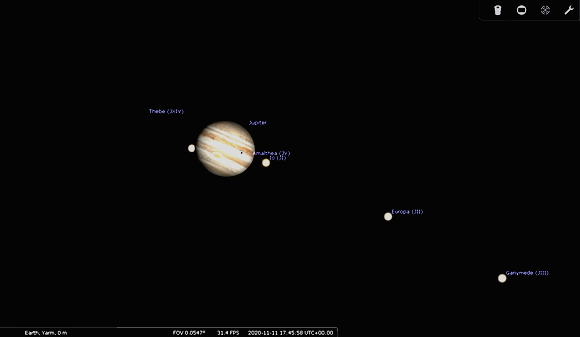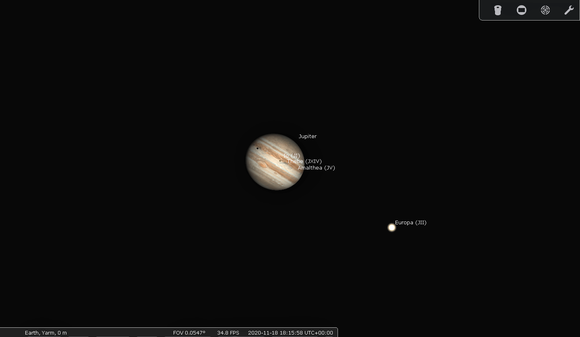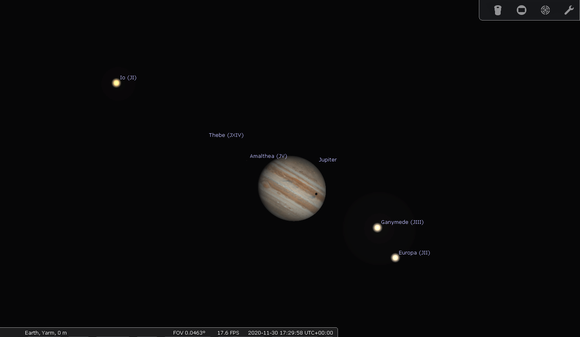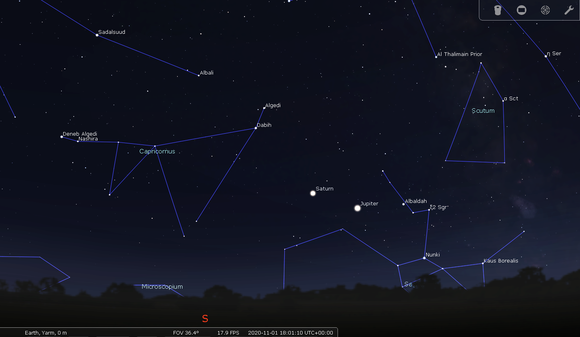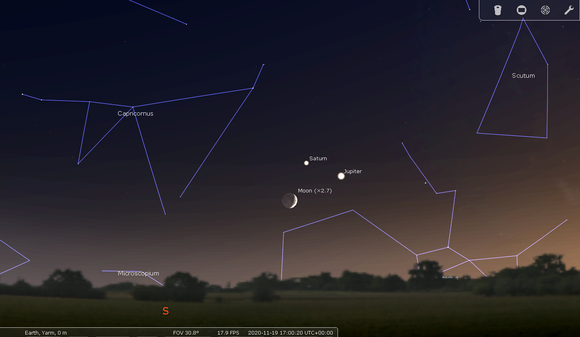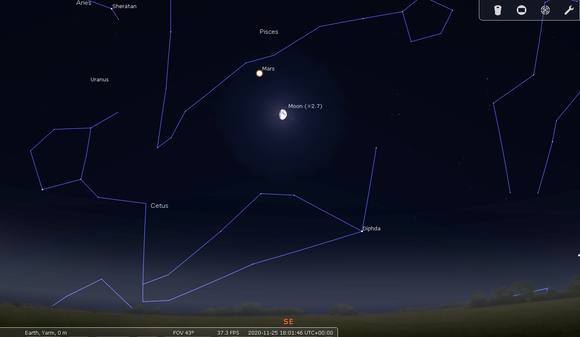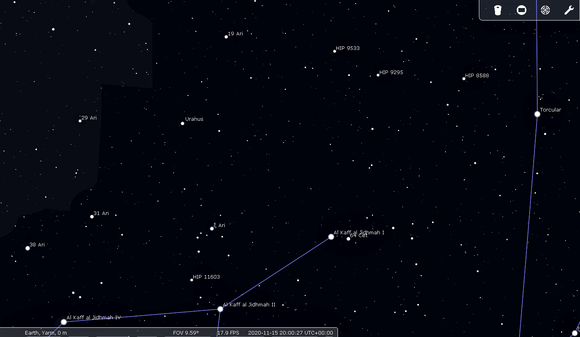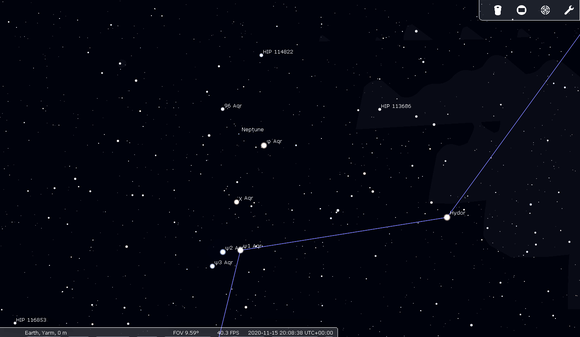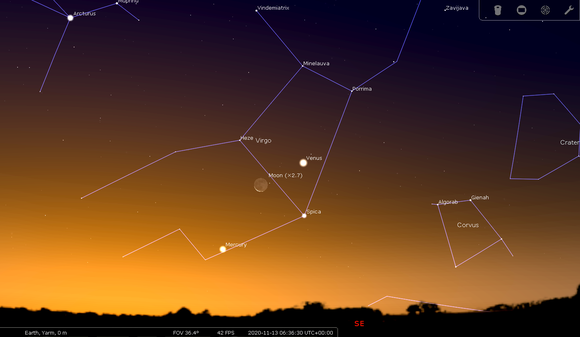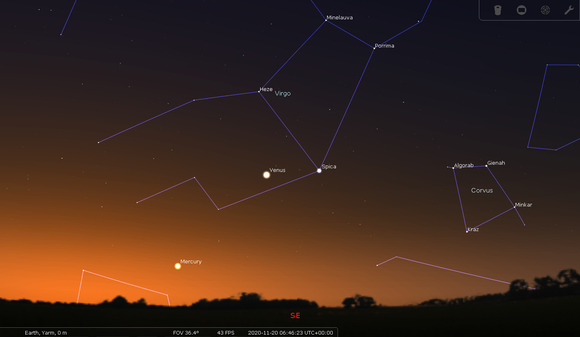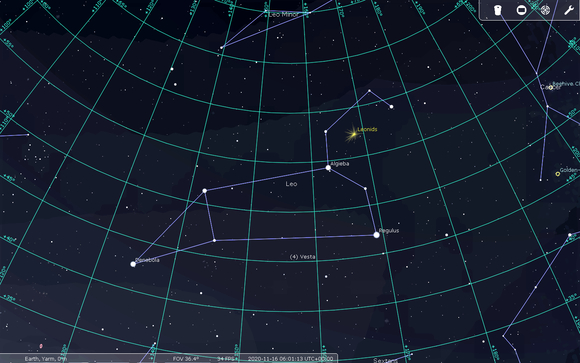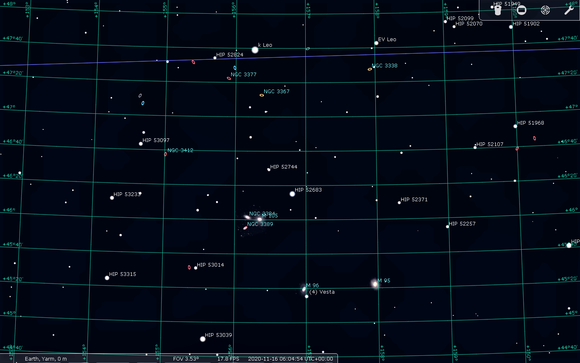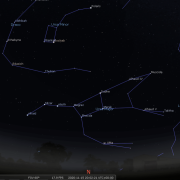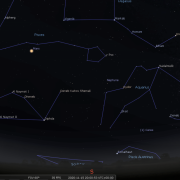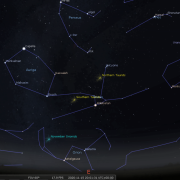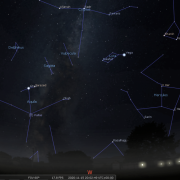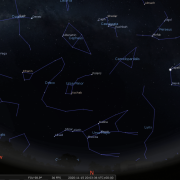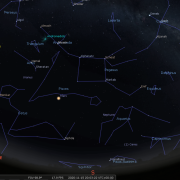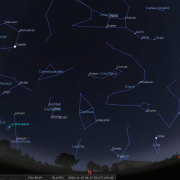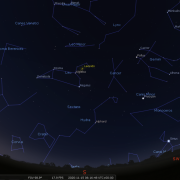In this month's Sky Notes:
Planetary Skylights - Brief
Mars now holds centre stage and for anyone with a half decent telescope, the Red planet should be your first port of call to view through the eyepiece. Actually, make that second or even third, because if you still want to take a peek at Jupiter and Saturn, they should be your first targets, located as they are low in SW sky and available for scrutiny for a limited time only before setting. At the start of November this will be around 20:00 GMT for Jupiter, with Saturn following 30mins later. By the end of the month it’s around 18:30 GMT when they depart.
 Jupiter remains conspicuous to the eye, and given steady seeing (which as it drops lower to the horizon becomes ever more erratic), there is still plenty to admire and scrutinize. The Great Red Spot (GRS) for instance appears to have stopped shrinking and turned far redder. It used to be three times the size it is now in the 1800’s. There are also a number of other storm features brewing, one immediately below the GRS and another on the North tropical zone band. So even though Jupiter is nearing the end of its apparition it’s worth observing to keep tabs on to compare with any changes that may occur before it reappears in the dawn sky early next year. The daily dance of the Galilean moons is also fascinating to watch, especially if there are shadow transits.
Jupiter remains conspicuous to the eye, and given steady seeing (which as it drops lower to the horizon becomes ever more erratic), there is still plenty to admire and scrutinize. The Great Red Spot (GRS) for instance appears to have stopped shrinking and turned far redder. It used to be three times the size it is now in the 1800’s. There are also a number of other storm features brewing, one immediately below the GRS and another on the North tropical zone band. So even though Jupiter is nearing the end of its apparition it’s worth observing to keep tabs on to compare with any changes that may occur before it reappears in the dawn sky early next year. The daily dance of the Galilean moons is also fascinating to watch, especially if there are shadow transits.
Jupiter GRS and Galilean moon shadow transit visibility:
-
1st - GRS visible 17:30h GMT(UT) until Jupiter sets
-
3rd - Callisto shadow transit visible before 16:50- 17:40h GMT
-
5th - GRS visible from 17:00- 19:00h GMT
-
8th - GRS visible from 18:00h GMT until Jupiter sets.
-
11th - GRS and Io shadow transit from 18:00h - 17:15h GMT
-
13th - GRS visible pre 17:00h GMT until Jupiter sets.
-
16th - GRS visible from 16:45h until 17:40h GMT
-
18th - GRS visible from 16:30h until 19:00h GMT and Io shadow transit from 18:00h GMT
-
20th - GRS visible from 17:00h GMT until Jupiter sets
-
23rd - GRS visible from 16:30-17:45h GMT
-
25th - GRS and Europa shadow transit visible from 17:00h - 17:30h GMT
-
28th - GRS visible from 16:30h GMT until sets
-
30th - GRS and Ganymede shadow transit visible from 16:30h until 18:00h GMT
 Saturn trails a short distance behind Jupiter and is much less conspicuous, but still readily visible to the naked eye. Binoculars (unless very powerful) fail to reveal the beautiful ring system, but even a very modest telescope will show that the rings are still well orientated with respect to Earth. Look also for Titan, Saturn’s largest moon, it will resemble a ‘bright speck’ nearby Saturn. Again, because of the low altitude of Saturn, to give yourself the best opportunity of 'semi decent' seeing, view early in the month and early in the evening. The moon passes by Jupiter and Saturn on the 19th. By the end of the month Jupiter is noticeably edging toward Saturn, closing to half the distance it started at the beginning of November. This continues into December leading to an end of year finale that will cause quite a stir, and will be one of the observing highlights of 2020! All we need are 3 wise men and 3 kings!
Saturn trails a short distance behind Jupiter and is much less conspicuous, but still readily visible to the naked eye. Binoculars (unless very powerful) fail to reveal the beautiful ring system, but even a very modest telescope will show that the rings are still well orientated with respect to Earth. Look also for Titan, Saturn’s largest moon, it will resemble a ‘bright speck’ nearby Saturn. Again, because of the low altitude of Saturn, to give yourself the best opportunity of 'semi decent' seeing, view early in the month and early in the evening. The moon passes by Jupiter and Saturn on the 19th. By the end of the month Jupiter is noticeably edging toward Saturn, closing to half the distance it started at the beginning of November. This continues into December leading to an end of year finale that will cause quite a stir, and will be one of the observing highlights of 2020! All we need are 3 wise men and 3 kings!
 And so to Mars, which could wait a few hours after all, not crossing the southern meridian until later in the evening, and residing much higher in the sky than Jupiter and Saturn ever did this year. As we head into November, Mars will still look the most dominant planet to the naked eye in the night sky, its soft fiery glow dominating the SE-S aspect at magnitude -2.1. By the month’s end however, Mars will have diminished quite markedly in intensity, to mag -1.2, its disk size will also have shrunk from 20 arc seconds to 14.5 arc seconds. If you can then, view Mars early in the month.
And so to Mars, which could wait a few hours after all, not crossing the southern meridian until later in the evening, and residing much higher in the sky than Jupiter and Saturn ever did this year. As we head into November, Mars will still look the most dominant planet to the naked eye in the night sky, its soft fiery glow dominating the SE-S aspect at magnitude -2.1. By the month’s end however, Mars will have diminished quite markedly in intensity, to mag -1.2, its disk size will also have shrunk from 20 arc seconds to 14.5 arc seconds. If you can then, view Mars early in the month.
Through binoculars, Mars is a bit of a disappointment, a very small orange dot. It has to be said that on many occasions it isn’t much better in a telescope either, usually to do with ‘seeing’, ie our turbulent atmosphere, or dust storms on Mars itself. People’s perceptions of what to expect in the eyepiece are also sometimes rather misguided. The Martian disk will certainly not fill the eyepiece (at least for most observers). Mars is a smallish world, considerably smaller than Earth, and only at favourable oppositions does it appear reasonably ‘less small’ so that surface detail can be made out. And it is the surface you will be peering at, not atmosphere or cloud, the actual surface of another world. Well hopefully it will be, as Mars can sometimes be engulfed in huge dust storms which turn the disk a featureless pinky/orange hue. For UK observers Mars is now at its best opposition until 2035, pretty high in the night sky in Pisces and so far, free from dust storms, (as of writing). The moon lies below Mars on the 25th.
 Uranus is now well placed to track down in the evening sky, residing just within the borders of Aries, approximately 10 degrees below the ‘crooked line’ asterism of the Ram marked by Hamal and Sheratan and Mesatim. Although not a naked eye object for the majority of people, at mag +5.7 Uranus is borderline naked eye for keen sighted observers viewing from dark viewing locations (assuming they know exactly where to look). Uranus can be located just over a degree west of the faint 6th mag star 29 Ari. Through binoculars Uranus resembles a rather faint star of subtle grey/green hue. You will require a telescope (modest size upwards) to discern its tiny disk, which appears to have a slightly ghoulish hue to it, at least to my eyes.
Uranus is now well placed to track down in the evening sky, residing just within the borders of Aries, approximately 10 degrees below the ‘crooked line’ asterism of the Ram marked by Hamal and Sheratan and Mesatim. Although not a naked eye object for the majority of people, at mag +5.7 Uranus is borderline naked eye for keen sighted observers viewing from dark viewing locations (assuming they know exactly where to look). Uranus can be located just over a degree west of the faint 6th mag star 29 Ari. Through binoculars Uranus resembles a rather faint star of subtle grey/green hue. You will require a telescope (modest size upwards) to discern its tiny disk, which appears to have a slightly ghoulish hue to it, at least to my eyes.
 Neptune resides in the constellation of Aquarius, just over 2 degrees north-east of the star Phi aqr (mag +4.2), whilst 96 aqr. (mag+5.5) lies 42 arc minutes to the WNW of it. You will definitely require a telescope to spot the diminutive disk, which has a blue/grey hue and using higher magnification will help. Binoculars only show it as a speck; again, assuming you know exactly where to look.
Neptune resides in the constellation of Aquarius, just over 2 degrees north-east of the star Phi aqr (mag +4.2), whilst 96 aqr. (mag+5.5) lies 42 arc minutes to the WNW of it. You will definitely require a telescope to spot the diminutive disk, which has a blue/grey hue and using higher magnification will help. Binoculars only show it as a speck; again, assuming you know exactly where to look.
Dawn Planets
 In the dawn sky Venus reins supreme, a brilliant beacon of mag - 4.1 above the ESE horizon. Over the course of November Venus slides back toward the horizon, passing the chief star in Virgo – Spica, which along with all the other stars in the eastern dawn sky heading the other way. Venus and Spica appear closest on the 17th. Unlike Mars, Venus’s surface is perpetually hidden by cloud and the view thru the eyepiece is rather bland. You will however observe the phase – which is a 88% gibbous.
In the dawn sky Venus reins supreme, a brilliant beacon of mag - 4.1 above the ESE horizon. Over the course of November Venus slides back toward the horizon, passing the chief star in Virgo – Spica, which along with all the other stars in the eastern dawn sky heading the other way. Venus and Spica appear closest on the 17th. Unlike Mars, Venus’s surface is perpetually hidden by cloud and the view thru the eyepiece is rather bland. You will however observe the phase – which is a 88% gibbous.
 Venus is not the only planet in the dawn sky, with Mercury putting on its best morning apparition this year. The elusive world is visible from the start of the month where it resides to the left of Spica. By the 10th it has gained in altitude to almost 12 degrees above the SE horizon, reaching greatest western elongation from the Sun, some 19 degrees. Mercury will then arc back toward the SE horizon, actually gaining in brightness as it does so. To observe Mercury, look for another ‘fairly bright star’ lower left of Spica at the start of November. At mag + 1.4 Mercury will appear slightly fainter than Spica. However, if possible view on the 13th around 6am, when Mercury, Spica, the Moon and Venus form a diamond pattern, a highlight this month certainly. Mercury will have brightened to mag -0.7 by then. By the end of the month Mercury will be around mag -1.0 but very low down. A clear SE horizon aspect is required. Use binoculars to help out initially. A telescope at high power will reveal a phase only; crescent at the start of November and gibbous by the end.
Venus is not the only planet in the dawn sky, with Mercury putting on its best morning apparition this year. The elusive world is visible from the start of the month where it resides to the left of Spica. By the 10th it has gained in altitude to almost 12 degrees above the SE horizon, reaching greatest western elongation from the Sun, some 19 degrees. Mercury will then arc back toward the SE horizon, actually gaining in brightness as it does so. To observe Mercury, look for another ‘fairly bright star’ lower left of Spica at the start of November. At mag + 1.4 Mercury will appear slightly fainter than Spica. However, if possible view on the 13th around 6am, when Mercury, Spica, the Moon and Venus form a diamond pattern, a highlight this month certainly. Mercury will have brightened to mag -0.7 by then. By the end of the month Mercury will be around mag -1.0 but very low down. A clear SE horizon aspect is required. Use binoculars to help out initially. A telescope at high power will reveal a phase only; crescent at the start of November and gibbous by the end.
13-Nov-2020 at 06:30h (E): Conjunction of Venus, Moon, Spica and Mercury
(Click for full-sized image)
Meteors

The Leonids are active from Nov 15-20th with this year’s peak over the night of the 17/18th. Conditions should be excellent with a New Moon just a few days before. In most years Leonid rates are around 25 per hour, rising to 100’s if not 1000’s during ‘storm’ years, which occur at intervals of roughly 33 years, coinciding with the return of the periodic parent comet Temple Tuttle. The next expected storm event will be sometime after 2030, but there is a possibility of some enhanced activity this year from a debris stream in the early morning hours of the 18th. We won’t know for definite until then. Leonids are very swift in nature often leaving trails. Should you be up and about and it is clear certainly keep a watch.
Also during November keep an eye out for a few meteors on the night of Nov 4/5th when the South Taurid meteor shower reaches a peak, and then again on the night of Nov 11/12 when the North Taurid meteor shower peaks. The hourly rate is low; only around 5 meteors, but although few, Taurids can produce a few fireballs! The Taurids are an old shower, associated with the periodic Comet Enke. Over time dust from this comet has been depleted and spread out over a broad swath of the inner solar system, giving rise to Taurid meteor showers not only on Earth but also on Mars and Venus. A moon will interfere markedly for the South Taurid shower, but much less so for North Taurids.
Vesta in Leo
If you fancy an intriguing challenge, try spotting the minor planet, Vesta in the dawn sky between Nov 15th and 17th. It lies just below Leo, which will be high to the south at 06:00GMT. At mag +8 you will require a small telescope to really appreciate the vista, but large binoculars may also suffice. Over the course of the 3 mornings, Vesta will pass between the galaxies M95 and M96, its presence therefore quite obvious. On the 15th it will lie upper left of M95 and a day later just below M96. Both galaxies are visible with a small telescope.
16-Nov -2020 at 06:00h (S): Detailed chart for Vesta splitting
M95 and M96 in Leo (Click for full-sized image)
November 2020 Sky Charts
Additional Image Credits:
- Planets and Comets where not otherwise mentioned: NASA
- Sky Charts: Stellarium Software
- Log in to post comments

